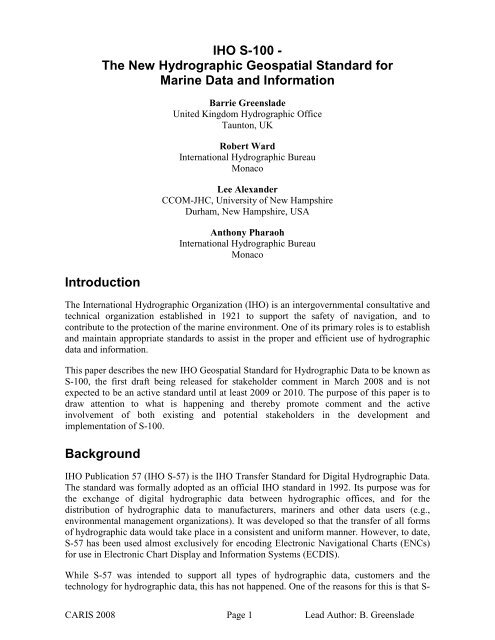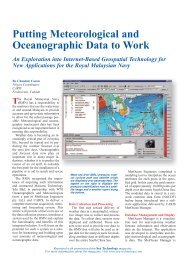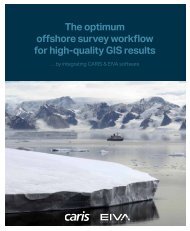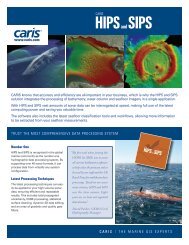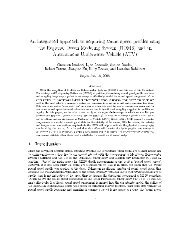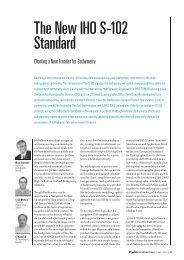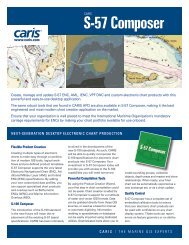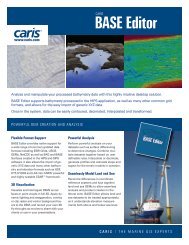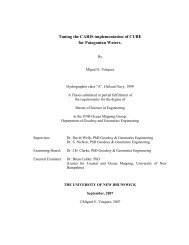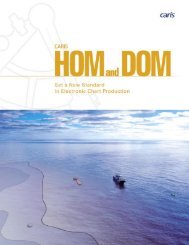GREENSLADE - Paper - Caris
GREENSLADE - Paper - Caris
GREENSLADE - Paper - Caris
Create successful ePaper yourself
Turn your PDF publications into a flip-book with our unique Google optimized e-Paper software.
IHO S-100 -<br />
The New Hydrographic Geospatial Standard for<br />
Marine Data and Information<br />
Introduction<br />
Barrie Greenslade<br />
United Kingdom Hydrographic Office<br />
Taunton, UK<br />
Robert Ward<br />
International Hydrographic Bureau<br />
Monaco<br />
Lee Alexander<br />
CCOM-JHC, University of New Hampshire<br />
Durham, New Hampshire, USA<br />
Anthony Pharaoh<br />
International Hydrographic Bureau<br />
Monaco<br />
The International Hydrographic Organization (IHO) is an intergovernmental consultative and<br />
technical organization established in 1921 to support the safety of navigation, and to<br />
contribute to the protection of the marine environment. One of its primary roles is to establish<br />
and maintain appropriate standards to assist in the proper and efficient use of hydrographic<br />
data and information.<br />
This paper describes the new IHO Geospatial Standard for Hydrographic Data to be known as<br />
S-100, the first draft being released for stakeholder comment in March 2008 and is not<br />
expected to be an active standard until at least 2009 or 2010. The purpose of this paper is to<br />
draw attention to what is happening and thereby promote comment and the active<br />
involvement of both existing and potential stakeholders in the development and<br />
implementation of S-100.<br />
Background<br />
IHO Publication 57 (IHO S-57) is the IHO Transfer Standard for Digital Hydrographic Data.<br />
The standard was formally adopted as an official IHO standard in 1992. Its purpose was for<br />
the exchange of digital hydrographic data between hydrographic offices, and for the<br />
distribution of hydrographic data to manufacturers, mariners and other data users (e.g.,<br />
environmental management organizations). It was developed so that the transfer of all forms<br />
of hydrographic data would take place in a consistent and uniform manner. However, to date,<br />
S-57 has been used almost exclusively for encoding Electronic Navigational Charts (ENCs)<br />
for use in Electronic Chart Display and Information Systems (ECDIS).<br />
While S-57 was intended to support all types of hydrographic data, customers and the<br />
technology for hydrographic data, this has not happened. One of the reasons for this is that S-<br />
CARIS 2008 Page 1 Lead Author: B. Greenslade
57 is not a contemporary standard that is widely accepted in the GIS domain. Accordingly,<br />
the IHO has embarked on the development of a new, more versatile standard – S-100 – that<br />
will comply with the ISO 19100 series of geographic information standards being developed<br />
by ISO Technical Committee 211. S-100 should therefore form an attractive basis upon<br />
which a wide range of digital products and transfer standards for hydrographic and related<br />
applications can then be developed in the future.<br />
Goals for S-100<br />
The primary goal for S-100 is to support a greater variety of hydrographic-related digital data<br />
sources, products, and customers. This includes matrix and raster data, time-varying data (x,<br />
y, z, and time), and new applications that go beyond the scope of traditional hydrography (for<br />
example, high-density bathymetry, seafloor classification, marine GIS). It will also enable the<br />
use of web-based services for acquiring, processing, analyzing, accessing, and presenting<br />
data. S-100 is not an incremental revision of the current Edition 3.1 of S-57. S-100 will be a<br />
new standard that includes both additional content and support of new data exchange formats.<br />
Due to the worldwide prominence of ISO standards, IHO S-100 will be based on the ISO<br />
suite of standards. However, alignment with the ISO 19100 series of geographic standards<br />
will require a different structure for S-100 compared to S-57. More specifically, this will<br />
involve a new framework, and new/revised terms to describe the components of S-100.<br />
S-100 was released as a draft version in February 2008. It is therefore in the development and<br />
testing phase. Meanwhile, IHO S-57 Edition 3.1 will continue to be used for many years to<br />
come -- even after S-100 becomes an active standard. As such, Hydrographic Offices will<br />
continue to produce S-57 ENC data to meet IMO ECDIS Performance Standard<br />
requirements, and to maintain world-wide ENC coverage. Any future ENC Product<br />
Specification will take several years to develop after publication of the S-100 base standard,<br />
and will involve the active participation of all IHO stakeholders.<br />
Current Limitations of S-57 Edition 3.1<br />
Although S-57 Edition 3.1 has many good aspects, it does have limitations:<br />
• It was primarily developed to meet the ENC requirement called for in an IMOcompliant<br />
ECDIS.<br />
• It has an inflexible maintenance regime. Freezing standards for lengthy periods is<br />
counter-productive.<br />
• As presently structured, it cannot support future requirements (e.g., gridded<br />
bathymetry, or time-varying information).<br />
• Embedding the data model within the encapsulation (i.e., file format) restricts the<br />
flexibility and capability of using a wider range of transfer mechanisms.<br />
• It is regarded by some as a limited standard focused exclusively for the<br />
production and exchange of ENC data.<br />
In order to address these and other limitations, the IHO Committee on Hydrographic<br />
Requirements for Information Systems (CHRIS) authorised work to begin on a major<br />
CARIS 2008 Page 2 Lead Author: B. Greenslade
evision of Edition 3.1. This revision will result in a new standard that includes both<br />
additional content and a new data exchange format. The draft version was released in early<br />
2008 as part of the development and testing phase for the standard (see also diagram 4).<br />
Goal/Objectives for S-100<br />
The primary goal for S-100 is to be able to support a greater variety of hydrographic-related<br />
digital data sources, products, and customers (see Figure 1). This includes imagery and<br />
gridded data, 3-D and time-varying data (x, y, z, and time), and new applications that go<br />
beyond the scope of traditional hydrography (for example, high-density bathymetry, seafloor<br />
classification, marine GIS, etc.). It will also enable the use of Web-based services for<br />
acquiring, processing, analysing, accessing, and presenting data.<br />
Figure 1 - S-100 will support a far greater variety of data sources, products and services<br />
Other goals include:<br />
• Separating the data content from the carrier (file format). In this way, data can be<br />
manipulated and encoded without being permanently tied to a single exchange<br />
mechanism.<br />
• Manageable flexibility that can accommodate change. The content of future<br />
product specifications will be a subset of S-100, including separate feature<br />
catalogues. This will allow the core standard to evolve (through extension)<br />
without the need to introduce new versions of product specifications.<br />
• An ISO-conforming registry on the IHO Web site containing registers for Feature<br />
data dictionaries, portrayal and metadata. The registers will accommodate both<br />
core hydrographic content and other chart related content, such as, Nautical<br />
Publications, Inland ENC and Marine Information Overlays.<br />
CARIS 2008 Page 3 Lead Author: B. Greenslade
ISO 19100 Standards<br />
The standards developed by ISO/TC211 are contained in the ISO 19100 series of geographic<br />
information standards. For all forms of geographic data, these standards specify the methods,<br />
tools, and services for:<br />
• Data management (including definition and description),<br />
• Acquiring, processing, analysing, accessing, and presenting data,<br />
• Transferring data in digital electronic form between different users, systems and<br />
locations.<br />
In the most general sense, these standards fall into one of the following categories:<br />
• Framework and Reference Model,<br />
• Profiles and Functional Standards,<br />
• Data Models and Operators,<br />
• Data Administration,<br />
• Geographic Information Services.<br />
Currently, there are over 40 standards in the ISO 19100 series. These include both formally<br />
adopted and draft International Standards for spatial and temporal schema, metadata, imagery<br />
and gridded data, profiles, portrayal, encoding, and so forth.<br />
Given the prominence of ISO standards and their worldwide recognition and use, it makes<br />
sense for IHO to adopt the ISO/TC211 suite of standards for S-100.<br />
S-100 Framework<br />
S-100 comprises multiple components that will be aligned with the ISO 19100 series of<br />
geospatial standards. Developing S-100 in this way will enable hydrographic data to be<br />
included in many more general geospatial applications as well as in the traditional<br />
hydrographic domains.<br />
Alignment with the ISO 19100 series of geographic standards will require that S-100 is<br />
organized and defined in a different way when compared to S-57. More specifically, it will<br />
require a new framework or structure, and a revised set of terms to describe the components<br />
of S-100. Proposals to achieve this are described later in this paper.<br />
The relationship between S-100 work packages and their ISO base classes is shown in Figure<br />
2.<br />
CARIS 2008 Page 4 Lead Author: B. Greenslade
ISO Packages<br />
ISO/TC211::ISO<br />
19126<br />
ISO/TC211::ISO<br />
19110<br />
ISO/TC211::ISO<br />
19107<br />
ISO / TC 211::ISO<br />
19113<br />
ISO/TC211::ISO<br />
19135<br />
S-100::Procedures<br />
for Item<br />
Registration<br />
S-100::Feature<br />
Data Dictionary<br />
S-100::Feature<br />
Catalogue<br />
S-100::Spatial<br />
ISO / TC 211::ISO<br />
19115<br />
S-100 Components<br />
S-100::Metadata<br />
ISO/TC211::ISO<br />
19109<br />
S-100::General<br />
Feature Model<br />
ISO / TC 211::ISO<br />
19115-2<br />
ISO/TC211::ISO<br />
19131<br />
S-100::Product<br />
Specifications<br />
S-100::Portrayal<br />
S-100::Coordinate<br />
Reference<br />
Systems<br />
S-100::Imagery<br />
and Gridded Data<br />
ISO / TC 211::ISO<br />
19114<br />
ISO/TC 211::ISO<br />
19117<br />
ISO/TC 211::ISO<br />
19111<br />
ISO/TC 211::ISO<br />
19129<br />
Encoding Standards<br />
ISO/IEC 8211<br />
ISO / TC 211::ISO19136<br />
(GML)<br />
ISO / TC 211::ISO19139<br />
(Metadata XML Schemas)<br />
ISO / TC 211::ISO19136<br />
(Encoding)<br />
Figure 2 - IHO S-100 Components and their Associated ISO Standards<br />
CARIS 2008 Page 5 Lead Author: B. Greenslade
specification. Initially there will be Registers for Hydrographic Information (based on the<br />
existing S-57 Feature and Attribute catalogues), Dynamic Ice Coverage, Nautical<br />
Publications and Inland ENCs. Other types of information that do not fit into these categories<br />
may be included in the Open ECDIS Forum (OEF) Register. For each Register there will be<br />
an organization that will be responsible for its content and management. A major benefit of<br />
the Registry concept is its flexibility. Multiple versions of similar entries in a data dictionary<br />
can be maintained using unique identification and classification. For instance, an entry can be<br />
classified as being either:<br />
• valid (latest version)<br />
• superseded (previous version/s)<br />
• retired (no longer recommended for use)<br />
• non valid (proposed but not accepted or no longer acceptable)<br />
In this way Product Feature Catalogues will reference items that will always remain valid<br />
even if a newer version of the referenced item is registered at a later date. This means that if a<br />
new item is registered or an existing item is upgraded, new versions of existing product<br />
specifications are not required. Non valid items will be visible in the Registers to ensure that<br />
any future proposals for similar items have not been previously rejected. The S-100 Registry<br />
entered into use in 2007 when the IHO Standardisation of Nautical Publications Working<br />
Group and the Inland ECDIS Harmonization Group began populating Registers with relevant<br />
information in support of Digital Nautical Publications and Inland ENCs respectively.<br />
Metadata Component<br />
Increasingly, hydrographic offices are collecting, storing and archiving large quantities of<br />
digital data which are becoming an important national asset. Knowledge of the quality of<br />
hydrographic data is crucial in ensuring that the data is used appropriately; different users and<br />
different applications often have different data quality requirements. In order to provide<br />
relevant details, data custodians will need to record quality information about their data. This<br />
will be at least one part of a metadata requirement.<br />
The S-100 metadata component makes provision for the creation of metadata records that<br />
provide information about the identification, spatial and temporal extent, quality, application<br />
schema, spatial reference system, and distribution of digital geographic data. It is applicable<br />
to the cataloguing of datasets, clearinghouse activities, and the full description of geographic<br />
and non-geographic resources. Although it is primarily intended to describe digital<br />
geographic data, it may also be used to describe other resources such as charts, maps, textual<br />
documents and non-geographic resources.<br />
Feature Catalogue Component<br />
This component provides improved flexibility including:<br />
• feature catalogues for individual product specifications can be constructed using<br />
either items referenced from the Data Dictionary Registers or new items defined<br />
in the catalogue itself.<br />
CARIS 2008 Page 7 Lead Author: B. Greenslade
• decisions about the binding between Features and Feature Attributes will be<br />
defined in the individual catalogue along with the unit of measure for numeric<br />
attributes.<br />
• a new Information Type is introduced which does not have any spatial attribution<br />
and will provide information about a feature by association. This could be a note<br />
associated with a pipeline or a buoy, for example.<br />
• a new complex attribute type is introduced. This is an extension of the ISO<br />
concept of an Attribute of an Attribute.<br />
Spatial Component<br />
The one and two-dimensional geometry of S-57 is being updated in S-100 to accommodate<br />
the use of a wider range of database and encoding applications. For example, the use of a<br />
composite curve to consolidate the individual curve components of a feature will simplify<br />
operations on such a feature in the software environment. Surfaces are being introduced to<br />
solve issues of area features truncated by data boundaries. This will accommodate the<br />
encoding of one area feature with one set of geometry, unlike in S-57 where several features<br />
using individual geometries are required to model what is actually a single feature.<br />
Imagery and Gridded Component<br />
This component defines specific grid organizations to be used for hydrographic data and<br />
images associated with hydrographic data. Both simple grids and complex multi-dimensional<br />
grids are defined.<br />
Hydrographic soundings are by their nature a set of measured data points. These data points<br />
can be represented in a grid structure in several different ways, including elevation models,<br />
using a regular grid spacing, and irregular grids with variable size cells or picture elements<br />
(pixels) that closely correspond to the handling of soundings as point sets.<br />
Images are also of great importance for hydrographic data. This includes images from sensors<br />
such as aerial photography or LIDAR, photographs that can be associated with vector based<br />
feature oriented data and scanned paper chart products, commonly known as “raster Charts.”<br />
All of these applications of imagery and gridded data will be catered for in S-100.<br />
Encoding Component<br />
S-100 itself will not mandate particular encoding formats. This means that the developers of<br />
Product Specifications can decide on the suitable encoding standard for their particular<br />
applications<br />
Initially S-100 will only provide an updated schema for ISO 8211 and schemas for GML<br />
including a version for Simple Features for use in web feature services. This will eventually<br />
be extended to include other formats as and when required.<br />
CARIS 2008 Page 8 Lead Author: B. Greenslade
Product Specification Component<br />
A Product Specification is a description of all the features, attributes and relationships of a<br />
given application and their mapping to a dataset. It is a complete description of all the<br />
elements required to define a particular geographic data product.<br />
This component is intended to ensure that any data product specification will maintain a<br />
similar structure.<br />
A product specification consists of the following basic parts:<br />
• product identification.<br />
• data content and structure<br />
• coordinate reference system.<br />
• data quality<br />
• data capture<br />
• data maintenance<br />
• portrayal<br />
• encoding<br />
• product delivery<br />
Maintenance Component<br />
S-100 will never be “frozen” although the frequency of new versions will be strictly<br />
controlled by the IHO as the Registry Owner. There will be three types of change proposal in<br />
S-100: clarification, correction and extension. Any change proposal must be one of these<br />
types.<br />
The maintenance regime has been changed considerably in comparison to that in S-57. The<br />
concept of a change being both a clarification and a correction has been removed. The new<br />
version control mechanism will be as follows:<br />
• Clarifications denoted as 0.0.x.<br />
• Corrections denoted as 0.x.0.<br />
• Extensions denoted as x.0.0.<br />
Benefits<br />
There are many benefits to be gained from adopting S-100:<br />
CARIS 2008 Page 9 Lead Author: B. Greenslade
• Using ISO-developed components and terminology will help ensure that S-100<br />
and future extensions are in the mainstream of the geospatial information<br />
industry. This should also help to encourage a greater use and thereby lower costs<br />
in implementing S-100 for hydrographic and other types of geospatial<br />
applications (for example, Marine GIS).<br />
• Conformance with the ISO/TC211 standards will maximize the use of<br />
commercial-off-the-shelf (COTS) software applications and development.<br />
• New components of S-100 will not be developed in isolation from the rest of the<br />
geospatial information technology community.<br />
• Any new requirements can be incorporated within the established framework of<br />
ISO/TC211 based standards.<br />
• Rather than being regarded as simply a standard for hydrography, S-100 will be<br />
interoperable with other ISO/TC211 standards and profiles such as NATO<br />
DIGEST.<br />
• There are many national standards bodies that will take full advantage of S-100<br />
being aligned with ISO/TC211 standards.<br />
• Compatible hydrographic data will be available to more than just hydrographic<br />
offices and ECDIS equipment.<br />
• It will enable hydrographic offices to use compatible sources of geospatial data,<br />
for example combining topography and hydrography to create a coastal zone<br />
map.<br />
Testing<br />
Various factors govern the breadth and depth of testing S-100, not the least being limited<br />
resources. The fact that S-100 is based on the ISO TC211 19100 series of standards and in<br />
turn ISO TC211’s close liaison with the Open Geospatial Consortium and its extensive<br />
testing facilities, should promote a reasonable level of confidence in the initial content. Also,<br />
the close cooperation between IHO and DGIWG in developing their respective standards will<br />
also ensure a sound foundation for content and interoperability. The new maintenance regime<br />
and the extensibility of S-100, coupled with the inclusive involvement of stakeholders in the<br />
development of product specifications will ensure more flexibility and ease of change than<br />
has been experienced with S-57.<br />
It is anticipated that the development of product specifications will be one of the most<br />
important testing environments. The St. Lawrence Seaway test bed is proof of this concept<br />
and in particular in testing the gridded data element which is new for S-100.<br />
Migrating from S-57 Edition 3.1 to S-100<br />
ENC data conforming to S-57 Edition 3.1 will continue to be a requirement for typeapproved,<br />
IMO-compliant ECDIS for the foreseeable future - even after S-100 has been<br />
released. As a consequence, hydrographic offices will continue, as at present, to produce<br />
Edition 3.1 ENC data to support this.<br />
CARIS 2008 Page 10 Lead Author: B. Greenslade
Implications for the ENC Product Specification<br />
It goes without saying that if any improved ENC Product Specification (such as S-101) is to<br />
be adopted in the future, it must provide mariners with useful new functionality. This could<br />
include such things as “plug and play” updating of data, symbology and software<br />
enhancements as well as the more efficient use of additional data created under S-100.<br />
Also, any development of S-101 will be undertaken over several years, and will involve the<br />
active participation of all stakeholders, including hydrographic offices, ENC software<br />
producers, ECDIS manufacturers, mariners, and other maritime users. The development,<br />
implementation and transition into force must also follow the IHO CHRIS governance model<br />
for IHO technical standards as illustrated in Figure 4.<br />
Committee Approval<br />
Committee Approval<br />
IHO Approval<br />
Identify Need<br />
Propose Develop Test Implement Implement Transition<br />
Old Standard New Standard<br />
Proposal Phase Development Phase Testing Phase Implementation Phase “Effective Standard”<br />
Stakeholder Feedback and Collaboration<br />
“Effective Standard”<br />
Effective Date<br />
Old Standard Superseded<br />
but still valid<br />
Retirement Date<br />
Procedure<br />
Reference<br />
1<br />
2, 3, 4 5 5 5 6 7 8 9<br />
Governance Live-Cycle for IHO Standards<br />
Figure 4 - Typical Lifecycle of an IHO Standard<br />
As a consequence of the extensive development process, any improved ENC Product<br />
Specification (S-101) could not come into force before at least 2012 and even then, the<br />
standard would sit alongside the existing S-57 Edition 3.1 Product Specification for some<br />
time. Furthermore, it is intended that any ECDIS which are upgraded to use S-101 ENCs will<br />
continue to be able to use S-57 Edition 3.1 ENCs as well.<br />
CARIS 2008 Page 11 Lead Author: B. Greenslade


